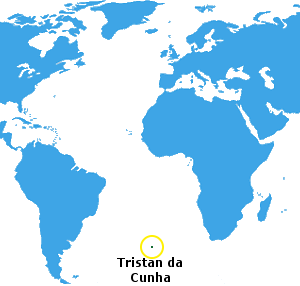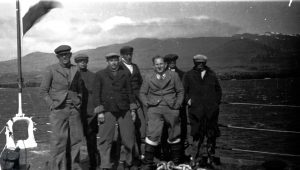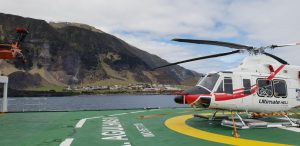The Tristan da Cunha Archipelago consists of the main island of Tristan da Cunha, the smaller, uninhabited Nightingale 
 and Inaccessible Islands and Gough Islands. Tristan was first discovered in 1506 by the Portuguese sailor Tristão da Cunha. However, Tristão was unable to land on Tristan because of accessibility difficulties and rough seas. Despite this, Tristão named the island ‘Ilha de Tristão da Cunha’ – roughly translated as ‘The Islands of Tristão da Cunha’. The name was changed to Tristan da Cunha at a later date. Tristan da Cunha is 2810 km or 1750 miles from Cape Town. In 1938 Gough Island was claimed for Britain, and became a dependency of Tristan da Cunha, which is part of the United Kingdom Overseas Territory of Saint Helena, Ascension and Tristan da Cunha. Tristan has an average diameter of 12kms (7.5 miles) and a circumference of about 40 km (25 miles). The volcanic cone which is Tristan da Cunha rises from an ocean plain some 3500 metres (11500 feet) below sea level and its peak reaches 2082 metres (6750 feet) above sea level – overall the Tristan volcano rises some 5500 metres (18000 ft) from the sea floor where it is about 48kms (30 miles) in diameter.
and Inaccessible Islands and Gough Islands. Tristan was first discovered in 1506 by the Portuguese sailor Tristão da Cunha. However, Tristão was unable to land on Tristan because of accessibility difficulties and rough seas. Despite this, Tristão named the island ‘Ilha de Tristão da Cunha’ – roughly translated as ‘The Islands of Tristão da Cunha’. The name was changed to Tristan da Cunha at a later date. Tristan da Cunha is 2810 km or 1750 miles from Cape Town. In 1938 Gough Island was claimed for Britain, and became a dependency of Tristan da Cunha, which is part of the United Kingdom Overseas Territory of Saint Helena, Ascension and Tristan da Cunha. Tristan has an average diameter of 12kms (7.5 miles) and a circumference of about 40 km (25 miles). The volcanic cone which is Tristan da Cunha rises from an ocean plain some 3500 metres (11500 feet) below sea level and its peak reaches 2082 metres (6750 feet) above sea level – overall the Tristan volcano rises some 5500 metres (18000 ft) from the sea floor where it is about 48kms (30 miles) in diameter.
The S.A. Agulhas II provides a cargo and passenger service to Tristan da Cunha each spring, normally departing Cape Town in early September. This is part of a lease arrangement of Gough Island to the South African Government where they maintain a Meteorological Station. The ship travels out to Tristan, then on to Gough for the annual exchange of personnel and cargo supply. The voyage gives passengers an opportunity to have a stay of about three weeks on Tristan, making it a very popular, and busy trip for visitors since the early visits by South African Naval Frigates, then the RSA from the 1960s followed by SA Agulhas from 1978 – 2011, and now SA Agulhas II.


 Tristan was ignored by early explorers as a possible home due to its rugged mountain landscape, absence of natural harbour, lack of land for agriculture, and a harsh climate with heavy rain and high winds at all seasons. It took an extra-ordinary breed of people, ready to live at the margins of life, to settle and eventually thrive in the world’s most isolated community.
Tristan was ignored by early explorers as a possible home due to its rugged mountain landscape, absence of natural harbour, lack of land for agriculture, and a harsh climate with heavy rain and high winds at all seasons. It took an extra-ordinary breed of people, ready to live at the margins of life, to settle and eventually thrive in the world’s most isolated community.
Only seven surnames survive on Tristan da Cunha in the 2006. Glass, Swain, Repetto. Lavarello, Green, Rogers and Hagan. The men from Tristan Island join Alan Crawford to establish a weather station in Marion Island
 (Left)Alan Crawford with Tristan Islanders on the SS Good Hope. View more images on the ALSA digital repository
(Left)Alan Crawford with Tristan Islanders on the SS Good Hope. View more images on the ALSA digital repository 
(Right)The base to be built on Marion Island had to be assembled from numerous wooden parts. Here the 6 volunteers from Tristan Island enjoy a meal before continuing with their construction activities. Dressed Sunday lunch and cave behind is La grange villa. Photo Credit: Julius Klette, Tom McSherry and Alan Crawford.




